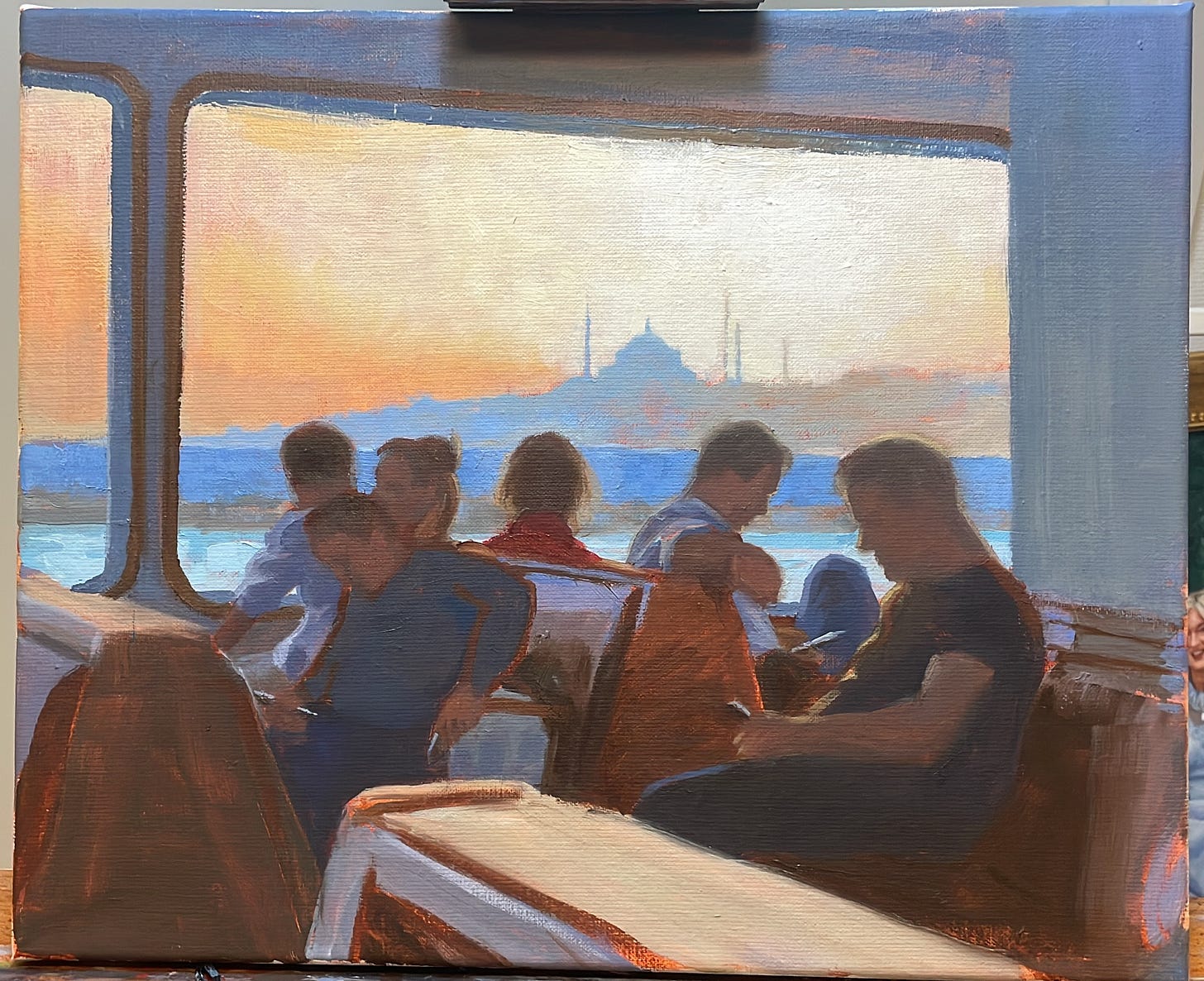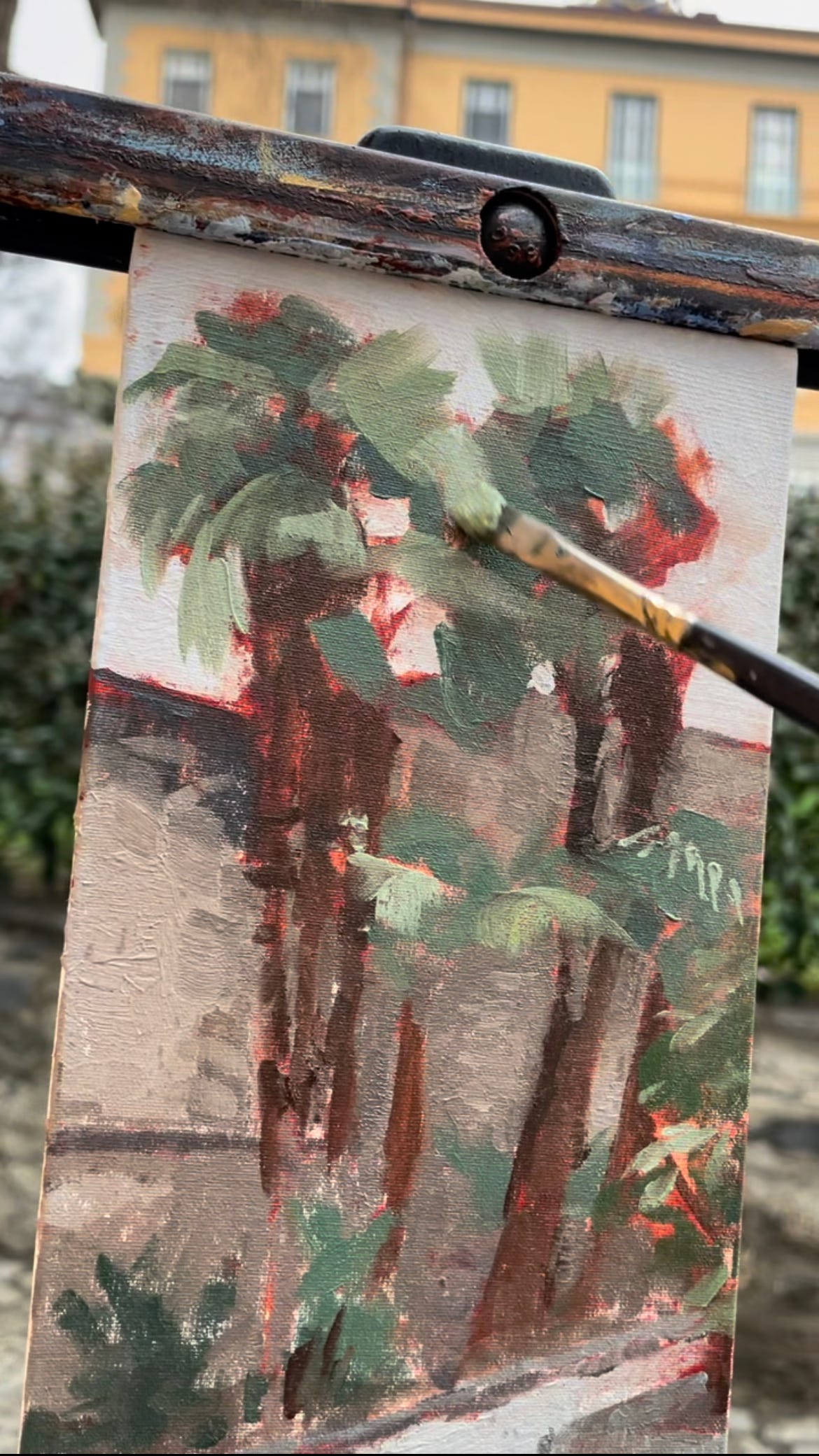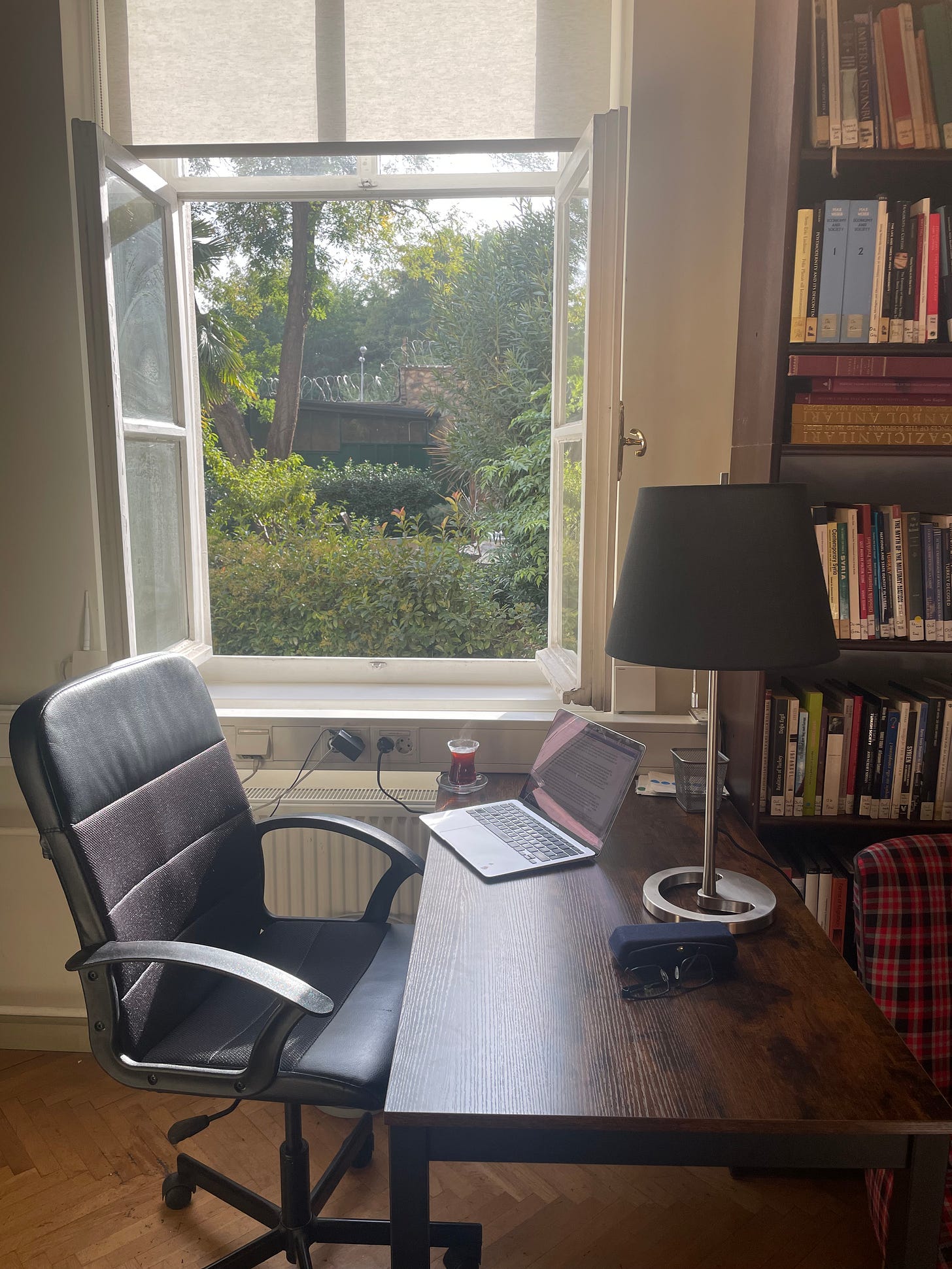Last year, I spent three months on a stipend from the Swedish Research Institute in Istanbul working on a research project. On the weekends, I brought my plein air easel on walks in the historic city and painted various motifs. At the end of my stay, I penned a brief philosophical reflection on my experiences for the Institute’s publication Kalabalik, and I thought I might as well publish it here. It is a meditation over the role of truth in art and research.
Reflections from an Istanbul garden
During my three-month stay at the Swedish Research Institute in Istanbul, I have taken weekend excursions to paint urban scenes, a technique known as painting en plein air. The phrase is French for “outdoors” and refers to the practice of landscape painting on site, as popularized by the French impressionists. I have been painting all my life and began painting more seriously about five years ago, but I have so far not succeeded in combining this passion with my work-related interest in the study of Turkey. That is, not until my stay at the Institute this year.
Painting is not the reason I am here, however. I have been here to work on a book about the Swedish and Turkish relationship to NATO, thanks to a three-month research fellowship from the Institute. The puzzle I am trying to solve in the book is why Turkey—a longstanding loyal NATO member—has recently begun acting as if it would really prefer to leave the organization, while Sweden suddenly abandoned its long-standing policy of non-alignment and decided to join the Western alliance. I do this by using the Swedish NATO accession process and the Turkish 20-month-long veto as a sort of looking glass through which to examine why states make major changes in their foreign and security policies.
As part of my research for the book, I have conducted interviews with experts, diplomats, and policy makers, and have made use of the Institute’s wonderful library, reading about Ottoman/Turkish-Swedish history. Most of the time, I have been sitting at one or another of the library’s workspaces, with a cup of Turkish tea on the desk and a view of the consulate’s peaceful garden outside the window. In fact, this is my view as I am writing this. A small garden fountain is making what looks like an upside-down glass bowl. It wobbles delicately and sometimes briefly breaks up and sprays in the wind.
Switching between doing research during the weekdays and painting scenes from Istanbul during the weekends has gotten me thinking about how the two activities compare. For one thing, both research and painting require careful observation. As a representational landscape painter, I will set up my portable easel in front of a scene, a motif, that somehow speaks to me, and then I set out to recreate the three-dimensional scene on a two-dimensional surface: my canvas. That involves careful study of the subject matter. It involves seeing without prejudice and often trying to make yourself forget what you know (that a ball is round) in order to capture what you actually see (a flat circle with a bright and a dark side).
Research is similar in a way. People who follow the news have intuitive understandings of major events, and I would venture to guess that most readers heard about the Swedish-Turkish negotiations over Sweden’s and Finland’s NATO membership and have a set of views about the process. So do I. But when doing research on it, it is important to try to unlearn what I think I know and try to really see what, in fact, is in front of me. What do my interview subjects tell me? What does the evidence tell me?
I cannot include all the evidence, of course. I have to make a selection of those facts I believe are most relevant. When I present answers to my research questions, those explanations will necessarily include simplifications, and those involve choices on my part. Should I include what key actors involved in the negotiations ate for breakfast, for example? Probably not, but not all choices are that easy.
Simplification and making choices are arguably even more important in painting. In my experience, the more I simplify, the better my painting becomes, to put it, well, simply.
In fact, this is where I see a major difference between good painting and good social scientific scholarship. A good plein air painting is a simplified representation of the motif, but not necessarily an accurate one. While you do have to learn to really see what is in front of you rather than what you expect, good painters “remove” trees or buildings, change the composition, or “push” (exaggerate) colors and values. They do so based on a sense of what will look good, on a design that they have in mind when they start painting, and/or on what they want to “say” with their painting. There is no lying in plein air painting. Design and interpretation are encouraged, and all that matters is the end result. Not only can you come to the work with a preconceived notion of the desired outcome, but your work may improve if you let that vision guide you.

What about social science then? Much work in the philosophy and sociology of science and epistemology over the past half-century has been aimed at shooting down a naïve view of social science modeled on the natural sciences, as the practice of testing theories using incontrovertible facts, a view often called positivism. Instead, truths are contextual, relative, and subjective, critics have argued. And the choices we make when simplifying or interpreting facts are not neutral but often laden with value assumptions. Feminist, intersectional, and post-colonial studies have argued that scholarly institutions and settings are pervaded by systematically inequitable power relations that inform such choices. The field of Middle Eastern (and Turkish) Studies was famously shaken by Edward Said’s critique of its orientalist origins.
I do not subscribe to positivism or to what the Hungarian philosopher and mathematician Imre Lakatos called “naïve falsificationism”. This is the view that what distinguishes scientific theories is that they are testable or falsifiable, and that such theories are simply discarded when facts prove them wrong. That is too simple an account. But I do think that there is a hugely important qualitative difference between good social science and art here. While subjective bias in art is good, it is not good in social science.
I may have preconceived notions and biases when it comes to my research subject, but I should at least try to leave those at the door. If all I do is tell the story that I already came in with, I have not only failed, but my research was in vain. While I must interpret and make sense of the various facts I collect, I must also allow for the possibility that they show that my preconceived notions were wrong. I should even be ready for my research to lead me to conclusions that go against my most deeply held political beliefs. My aim must be to come up with the most likely explanations, the best interpretations, not the ones that will satisfy me personally or align with my politics.
Some critical scholars may balk at this. My own mentor, the inimitable Hayward R. Alker, stressed what he called the emancipatory research interest. However, even an emancipatory political project needs a solid understanding of how the world actually works if it is to hold out any hope of improving it. To paraphrase Karl Marx, the point may be to change the world, but you won’t be able to do so unless you first understand it.
In my view, one of the main contributions of feminist and post-colonial writings about truth and power is that they have alerted us to systematic sources of bias that many scholars previously ignored while claiming to be “color blind” or objective. But some very different recent movements—led by figures like Donald Trump and Vladimir Putin—have also made important, albeit inadvertent, contributions to our understanding of the importance of truth. Trump’s “alternative facts” and Putin’s deliberate campaigns of disinformation have revealed the dangers of giving up on the notion of truth altogether, of believing that social science is all just politics “all the way down.” In fact, we could not even speak of their lies unless we held on to some notion of truth.
I do not think that the radical critiques of positivism require us to say that social science scholarship is like painting in the sense that there are no rules, that you are entirely free to interpret using your own voice, and that all that matters is that you embrace the right (emancipatory) biases, and do so openly. To do so would be to throw out the baby with the bathwater. I believe in both careful observation and informed interpretation, and that following basic scientific methodology and being self-conscious about structural biases can help me discover and control them. The above-mentioned Hayward Alker laid out a set of principles for doing so in his essay on “Emancipatory Empiricism.” It was aimed at the field of peace research, but it contains valuable advice for others as well. Hence, I not only check and double-check my facts and sources and deliberately look for alternative explanations and ways in which I may be wrong, but also try to make methodological decisions transparent and examine their normative basis.
Such research is a slow and painstaking process, and that leads me to my final point of comparison between scholarship and plein air painting. They both offer me shelter in a way: opportunities to step out of my high-paced, social-media-feed-driven life and focus on just one thing, and to do that thing slowly and carefully.
As I am looking out through my window at the garden of the institute, I realize that it, too, is a shelter. It is an oasis of sorts in the otherwise fast-paced, bustling city that is Istanbul. And I am grateful for the opportunity to spend some time here, reading, observing, writing, and painting.



